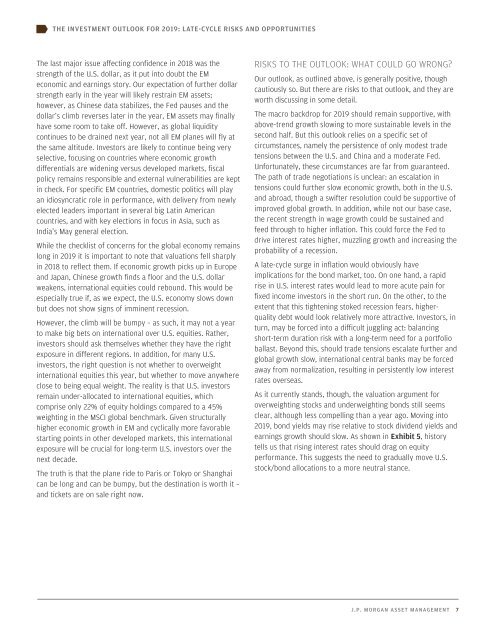You also want an ePaper? Increase the reach of your titles
YUMPU automatically turns print PDFs into web optimized ePapers that Google loves.
THE INVESTMENT OUTLOOK FOR 2019: LATE-CYCLE RISKS AND OPPORTUNITIES<br />
The last major issue affecting confidence in 2018 was the<br />
strength of the U.S. dollar, as it put into doubt the EM<br />
economic and earnings story. Our expectation of further dollar<br />
strength early in the year will likely restrain EM assets;<br />
however, as Chinese data stabilizes, the Fed pauses and the<br />
dollar’s climb reverses later in the year, EM assets may finally<br />
have some room to take off. However, as global liquidity<br />
continues to be drained next year, not all EM planes will fly at<br />
the same altitude. Investors are likely to continue being very<br />
selective, focusing on countries where economic growth<br />
differentials are widening versus developed markets, fiscal<br />
policy remains responsible and external vulnerabilities are kept<br />
in check. For specific EM countries, domestic politics will play<br />
an idiosyncratic role in performance, with delivery from newly<br />
elected leaders important in several big Latin American<br />
countries, and with key elections in focus in Asia, such as<br />
India’s May general election.<br />
While the checklist of concerns for the global economy remains<br />
long in 2019 it is important to note that valuations fell sharply<br />
in 2018 to reflect them. If economic growth picks up in Europe<br />
and Japan, Chinese growth finds a floor and the U.S. dollar<br />
weakens, international equities could rebound. This would be<br />
especially true if, as we expect, the U.S. economy slows down<br />
but does not show signs of imminent recession.<br />
However, the climb will be bumpy – as such, it may not a year<br />
to make big bets on international over U.S. equities. Rather,<br />
investors should ask themselves whether they have the right<br />
exposure in different regions. In addition, for many U.S.<br />
investors, the right question is not whether to overweight<br />
international equities this year, but whether to move anywhere<br />
close to being equal weight. The reality is that U.S. investors<br />
remain under-allocated to international equities, which<br />
comprise only 22% of equity holdings compared to a 45%<br />
weighting in the MSCI global benchmark. Given structurally<br />
higher economic growth in EM and cyclically more favorable<br />
starting points in other developed markets, this international<br />
exposure will be crucial for long-term U.S. investors over the<br />
next decade.<br />
The truth is that the plane ride to Paris or Tokyo or Shanghai<br />
can be long and can be bumpy, but the destination is worth it –<br />
and tickets are on sale right now.<br />
RISKS TO THE OUTLOOK: WHAT COULD GO WRONG?<br />
Our outlook, as outlined above, is generally positive, though<br />
cautiously so. But there are risks to that outlook, and they are<br />
worth discussing in some detail.<br />
The macro backdrop for 2019 should remain supportive, with<br />
above-trend growth slowing to more sustainable levels in the<br />
second half. But this outlook relies on a specific set of<br />
circumstances, namely the persistence of only modest trade<br />
tensions between the U.S. and China and a moderate Fed.<br />
Unfortunately, these circumstances are far from guaranteed.<br />
The path of trade negotiations is unclear: an escalation in<br />
tensions could further slow economic growth, both in the U.S.<br />
and abroad, though a swifter resolution could be supportive of<br />
improved global growth. In addition, while not our base case,<br />
the recent strength in wage growth could be sustained and<br />
feed through to higher inflation. This could force the Fed to<br />
drive interest rates higher, muzzling growth and increasing the<br />
probability of a recession.<br />
A late-cycle surge in inflation would obviously have<br />
implications for the bond market, too. On one hand, a rapid<br />
rise in U.S. interest rates would lead to more acute pain for<br />
fixed income investors in the short run. On the other, to the<br />
extent that this tightening stoked recession fears, higherquality<br />
debt would look relatively more attractive. Investors, in<br />
turn, may be forced into a difficult juggling act: balancing<br />
short-term duration risk with a long-term need for a portfolio<br />
ballast. Beyond this, should trade tensions escalate further and<br />
global growth slow, international central banks may be forced<br />
away from normalization, resulting in persistently low interest<br />
rates overseas.<br />
As it currently stands, though, the valuation argument for<br />
overweighting stocks and underweighting bonds still seems<br />
clear, although less compelling than a year ago. Moving into<br />
2019, bond yields may rise relative to stock dividend yields and<br />
earnings growth should slow. As shown in Exhibit 5, history<br />
tells us that rising interest rates should drag on equity<br />
performance. This suggests the need to gradually move U.S.<br />
stock/bond allocations to a more neutral stance.<br />
J.P. MORGAN ASSET MANAGEMENT 7
















